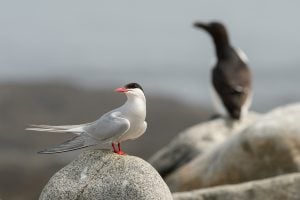
Wildlife
Should we kill one bird to save another?
On New Brunswick’s Machias Seal Island, predatory gulls are pushing endangered Arctic tern colonies to the brink, creating a dilemma for wildlife managers
- 2151 words
- 9 minutes
This article is over 5 years old and may contain outdated information.
Wildlife

If you’re walking near Misery Bay, Ont., you might run into what looks like turtles. But they’re actually decoys for predators.
Last year, almost 50 blanding’s turtles were found dead on Manitoulin Island. Now, researchers at Laurentian University are using fake turtles to find out what killed the slow-moving reptile.
According to Jacqueline Litzgus, a biology professor at Laurentian University and part of the research team, these bright yellow chin turtles are endangered. She says an increase of merely one to two per cent of deaths can be detrimental to the population. But in Misery Bay, over half the population were wiped out.
“From a conservation perspective, this is very alarming,” she says.
By figuring out what is killing the blanding’s turtles, researchers hope to bring back the population to what it was before.
“By protecting the blanding’s turtle, you protect the entire wet land ecosystem,” Litzgus says.

Researchers looked into different possibilities to understand what killed the turtles. Litzgus says results showed very little evidence of any disease. Currently, researchers are trying to rule out winter mortality by testing water temperatures. If last year’s water temperature was lower than usual, it could mean the water froze, leaving no oxygen for the turtles to breath.
But Litzgus says the turtles were most likely killed by predators. The turtles were dead for a while when their carcasses were discovered and there were scratches and teeth marks on them. “They were picked clean.”
In addition to the two turtle decoys, the team has set up cameras to capture video of the culprits. The decoys are made of rubber and foam. To mask the smell, researchers added turtle urine.
The cameras have been up for a week, but they have only captured a couple of Canada geese so far.
Are you passionate about Canadian geography?
You can support Canadian Geographic in 3 ways:

Wildlife
On New Brunswick’s Machias Seal Island, predatory gulls are pushing endangered Arctic tern colonies to the brink, creating a dilemma for wildlife managers

Mapping
Canadian Geographic's cartographer Chris Brackley shares insights into his process in charting the country's largest islands for an exclusive wall map

Wildlife
An estimated annual $175-billion business, the illegal trade in wildlife is the world’s fourth-largest criminal enterprise. It stands to radically alter the animal kingdom.

Wildlife
Salmon runs are failing and grizzlies seem to be on the move in the islands between mainland B.C. and northern Vancouver Island. What’s going on in the Broughton Archipelago?